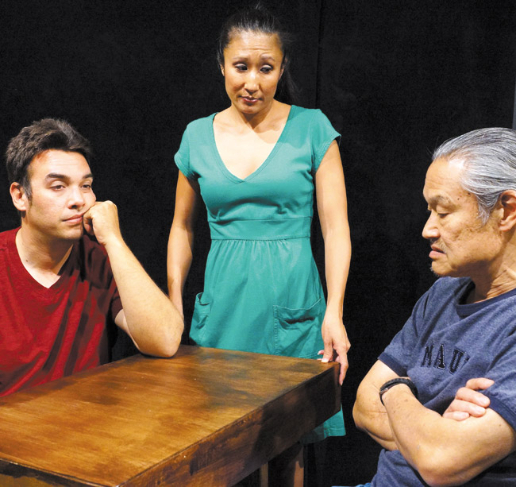Authentic Slant To Fictional Japan
I haven’t seen a classic, full-scale rendition of The Mikado, but I did see a Punahou production several years back and was instantly taken with the outrageous plot turns, memorable assortment of characters and unforgettably fantastical names like Poo-Bah and Pish-Tush.
“It’s one of the most popular pieces in the Hawaiian Islands,” notes Hawaii Opera Theatre artistic director Henry Akina. HOT staged Mikado in 2004, and it’s been done by Oahu’s top theatrical venues, including Diamond Head, Manoa Valley and Kennedy theatres.
mw-art-061114-koi
The Gilbert and Sullivan masterpiece is set in Japan. Nanki-Poo, the son of the Mikado (emperor) of Japan, is traveling incognito to escape an undesired betrothal. On his journey, he falls in love, but alas, his paramour Yum-Yum already is promised to someone else. Meanwhile, the ambience bears no qualitative resemblance to the Asia that anyone in Hawaii has ever visited.
“It’s Asian-ish, sort of. We call it the world of topsy-turvy,” says Akina, who has given the opera a contemporary makeover with characters dressed in fashion inspired by Harajuku, yakuza and anime, making this a Mikadounlike anyone has seen before. “The updating we’ve done bleeds into the set and the text, but generally the costumes are the vibrant element that really makes it.”
Akina says despite the modern flair, the production stays true to its traditional roots, so purists will enjoy it too. Mikado was penned in 19th century London as a critique of British politics and aristocracy, but as Akina points out, it’s just as relevant today:
“You’ll find that a lot of the things Gilbert and Sullivan are criticizing are still rampant today, and the stereotypes Gilbert and Sullivan engage in also are rampant. It’s not just about entertainment at the opera. I think there’s also a message to Mikado.”
This rendition makes use of some of the same talent as HOT’s 2004 production, with Kenny Endo again doing taiko drumming, Hawaii’s Jamie Offenbach reprising his role as the Mikado, and Curt Olds stepping in again as Koko, the Lord High Executioner to whom Yum-Yum is engaged. The rest of the cast, and particularly the set and costumes, are markedly different. Ten years ago, the cast was dressed in kimonos and happi coats, while today Anne Namba lent her designer’s eye to the wardrobe.
“Harajuku Girls are tied to shopping and cell phones,” says Akina about the look Namba is going for. “Harajuku is a movement that’s not so new, that’s related to shopping and things we might consider superficial.”
It’s defined by youth and fashion and gets its name from the trendy shopping district where the movement was born.
“The Mikado premieres Friday the 13th under a full moon, and it’s going to be good,” says Akina, who’s been with HOT 18 years. “This is not a tragic opera. It’s fun, and if we’re not having fun, are we in the right place at the right time? We should be having fun with it!”
Akina says rather than casting his vision on the production, he brings the components together and lets the magic percolate. Together with Namba’s touch and the expertise of aforementioned leads and their fellow opera stars — Joshua Kohl as Nanki-Poo and Sarah Asmar as Yum-Yum — Mikado has “developed very strongly with a very strong cast,” assures Akina. There’s also the HOT chorus, all locally based, who volunteer their time to round out what promises to be another of HOT’s splendid shows this season, following Turandotand the pairing of Pagliacci and Carmina Burana. Next season, HOT is upping its offerings to four operas, beginning in October with the perennially popular Madama Butterfly.
the TICKET stub
THE MIKADO
When: June 13-15, 20-22
Where: Neil Blaisdell Concert Hall
Cost: $34-$125
More Info: 596-7858, hawaiiopera.org
ALSO SHOWING
Fish Out of Water
In science, we learn that systems necessarily careen toward entropy, in effect moving from order to disorder and decay. The same goes with human life and the family social network, particularly as presented in Kumu Kahua’s latest, Koi, Like the Fish (through June 29, kumukahua.org). Like the sunshiny establishing shot that often marks sinister movies, Koi opens on a decently comfortable family scenario. Koi, a stoically sympathetic character played by John Wat, is elderly, ill and in need of live-in help. His son is about to get married, so niece Yosepha, played by Nani Morita, agrees to move in, and brings her husband and new baby along. (With the play set on Maui, I found myself wondering if folks over there really use the interjection “yo” a lot, until I realized that’s the niece’s name. Sounds silly, but my group had a chuckle when we discovered we’d all had the same misunderstanding.)
Through interactions with his family and visits from a bubbly mailwoman (Danielle Zalopany), we learn that Koi was once handsome, strong and quite a surfer. Now he’s reduced to sitting alone in his home, just like the final, lone koi in its diminishing pond in the backyard. In moves the niece, and relations go quickly south. The play is ultra-realistic and tackles difficult topics from elderly abuse to absentee spouses and selfish family members.
As this mini family cosmos implodes toward a weighty and metaphorically haunting conclusion, it’s easy to want to shine some light into the dark corners of these bruised lives. The mailwoman does that for Koi to an extent, but only enough to more sharply highlight the misery these suffocating souls endure.






